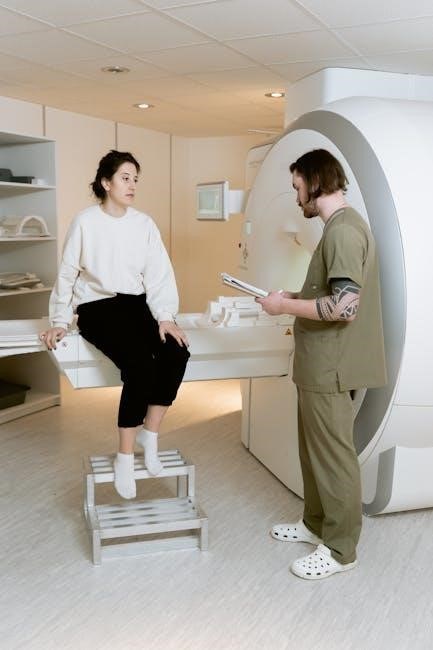and techniques to evaluate communication, quality of life, and overall well-being for people with dysarthria through various
resources
available online today always.
Definition and Importance of Dysarthria Assessment
Dysarthria assessment is a crucial process that involves evaluating an individual’s speech and communication abilities to determine the presence and severity of dysarthria. This assessment is essential for developing effective treatment plans and interventions to improve communication, quality of life, and overall well-being. The definition of dysarthria assessment encompasses a range of methods and techniques used to evaluate speech disorders, including perceptual, acoustic, and instrumental assessments. Understanding the importance of dysarthria assessment is vital for healthcare professionals, researchers, and individuals affected by dysarthria. By recognizing the significance of dysarthria assessment, we can better appreciate the need for comprehensive evaluations and tailored interventions. The availability of dysarthria assessment resources, such as PDF guides and online tools, has made it easier for professionals to conduct assessments and develop effective treatment plans. These resources provide valuable information on assessment methods, techniques, and data sources, ultimately contributing to improved outcomes for individuals with dysarthria. Effective dysarthria assessment is critical for enhancing communication abilities and promoting overall well-being.
Overview of Dysarthria Assessment Tools and Techniques
Dysarthria assessment tools and techniques are diverse and varied, ranging from perceptual assessments to instrumental evaluations. These tools and techniques are used to evaluate speech characteristics, such as articulation, voice quality, and fluency. The use of
audio recordings
and
speech analysis software
has become increasingly popular in dysarthria assessment, allowing for more accurate and reliable evaluations. Additionally,
standardized assessment protocols
and
rating scales
are commonly used to assess speech intelligibility and communication effectiveness. These tools and techniques provide valuable information on an individual’s speech abilities and can inform treatment decisions. By utilizing a range of dysarthria assessment tools and techniques, healthcare professionals can develop a comprehensive understanding of an individual’s speech disorder and create effective treatment plans. The selection of assessment tools and techniques depends on the individual’s specific needs and the goals of the assessment. Overall, dysarthria assessment tools and techniques play a critical role in evaluating and managing speech disorders. They are essential for healthcare professionals working with individuals with dysarthria.

Components of Dysarthria Assessment
Includes evaluation of speech and language using various
methods
and techniques to assess communication abilities and overall
wellbeing
effectively always online today.
Subjective Intelligibility Rating Methods
Subjective intelligibility rating methods are used to assess the severity of dysarthria, relying on the listener’s perception of speech intelligibility, which is a crucial aspect of communication. These methods involve rating the speaker’s ability to convey messages effectively, taking into account factors such as articulation, pronunciation, and fluency. The ratings are often based on a scale, with higher scores indicating better speech intelligibility. This approach provides a simple and viable alternative to objective methods, allowing clinicians to quickly assess a patient’s communication abilities. By using subjective intelligibility rating methods, clinicians can identify areas of strength and weakness, informing the development of targeted treatment plans. The use of these methods is supported by research, which highlights their reliability and validity in assessing dysarthria. Overall, subjective intelligibility rating methods are a valuable tool in the assessment of dysarthria, providing a comprehensive understanding of an individual’s communication abilities.
Objective Methods for Dysarthria Assessment
Objective methods for dysarthria assessment involve the use of instrumental techniques to evaluate speech production, providing a quantitative measure of speech characteristics. These methods include acoustic analysis, which examines the physical properties of speech sounds, and physiological measures, such as electromyography, which assess the muscle activity involved in speech production. Other objective methods include aerodynamic assessment, which evaluates the airflow and pressure characteristics of speech, and kinematic analysis, which examines the movement of the articulators. These methods provide a detailed and accurate assessment of dysarthria, allowing clinicians to identify specific speech deficits and track changes in speech production over time. By using objective methods, clinicians can develop targeted treatment plans and monitor progress, ultimately improving the effectiveness of dysarthria treatment. The use of objective methods in dysarthria assessment is supported by research, which highlights their reliability and validity in evaluating speech production.

Dysarthria Assessment PDF and Resources
Dysarthria assessment resources include online templates and
guides
for evaluating speech disorders and creating personalized treatment plans quickly and easily always using available resources.
Frenchay Dysarthria Assessment and Its Components
The Frenchay Dysarthria Assessment is a comprehensive evaluation tool used to assess speech disorders, providing a detailed understanding of an individual’s communication abilities and limitations. This assessment includes various components, such as speech, language, and cognitive evaluations, which are used to develop personalized treatment plans. The Frenchay assessment is widely used by speech-language pathologists to evaluate and manage dysarthria, a speech disorder characterized by slurred or difficult-to-understand speech. The assessment involves a series of tests and evaluations, including speech samples, language tests, and cognitive assessments, which are used to identify the underlying causes of dysarthria and develop effective treatment strategies. By using the Frenchay Dysarthria Assessment, speech-language pathologists can create individualized treatment plans that address the unique needs and goals of each patient, ultimately improving their communication abilities and quality of life. The assessment is an essential tool in the diagnosis and management of dysarthria, and its components are designed to provide a comprehensive understanding of the disorder.
ASHA Resources for Dysarthria Assessment and Management
The American Speech-Language-Hearing Association (ASHA) provides a range of resources for dysarthria assessment and management, including guidelines, assessment tools, and treatment strategies. These resources are designed to support speech-language pathologists in their work with individuals with dysarthria, and include information on best practices, evidence-based interventions, and outcome measurement. The ASHA website offers a wealth of information on dysarthria, including articles, webinars, and online courses, as well as a range of assessment tools and materials that can be downloaded or purchased. Additionally, ASHA provides a directory of certified speech-language pathologists who specialize in dysarthria assessment and treatment, making it easier for individuals to find qualified professionals in their area. By utilizing these resources, speech-language pathologists can provide high-quality care and support to individuals with dysarthria, and help them to achieve their communication goals. ASHA resources are widely respected and used by professionals in the field of speech-language pathology.

Techniques for Improving Dysarthria
Respiratory techniques enhance phonation through exercises and improve speech quality using various
methods
and online resources always available today online.
Respiratory Techniques for Enhancing Phonation
Respiratory techniques play a crucial role in enhancing phonation for individuals with dysarthria, as they help improve breath support and control. By using various exercises and methods, individuals can strengthen their respiratory muscles and increase their lung capacity, leading to better speech quality. These techniques can be learned through online resources, such as videos and tutorials, or with the help of a speech-language pathologist. The goal of respiratory techniques is to improve the coordination and timing of breathing and speech, allowing individuals to communicate more effectively. With consistent practice and training, individuals with dysarthria can experience significant improvements in their speech and overall communication abilities. Respiratory techniques are an essential component of dysarthria treatment and can be used in conjunction with other therapies to achieve optimal results. By incorporating these techniques into their daily routine, individuals with dysarthria can enhance their phonation and improve their quality of life.

and Future Directions
Importance of Comprehensive Dysarthria Assessment and Management
The importance of comprehensive dysarthria assessment and management cannot be overstated, as it plays a crucial role in improving communication, quality of life, and overall well-being for people with dysarthria. A comprehensive assessment involves evaluating the individual’s speech, language, and cognitive abilities, as well as their physical and emotional needs. This information is then used to develop a personalized treatment plan that addresses the individual’s specific needs and goals. By using a comprehensive approach, speech-language pathologists can help individuals with dysarthria to improve their communication skills, increase their independence, and enhance their overall quality of life. Additionally, comprehensive dysarthria assessment and management can also help to identify any underlying conditions that may be contributing to the individual’s dysarthria, such as neurological or respiratory disorders. By addressing these underlying conditions, individuals with dysarthria can receive more effective treatment and improve their overall health and well-being. Effective management of dysarthria requires a team approach, involving speech-language pathologists, occupational therapists, and other healthcare professionals. With the right assessment and management, individuals with dysarthria can lead fulfilling and productive lives.